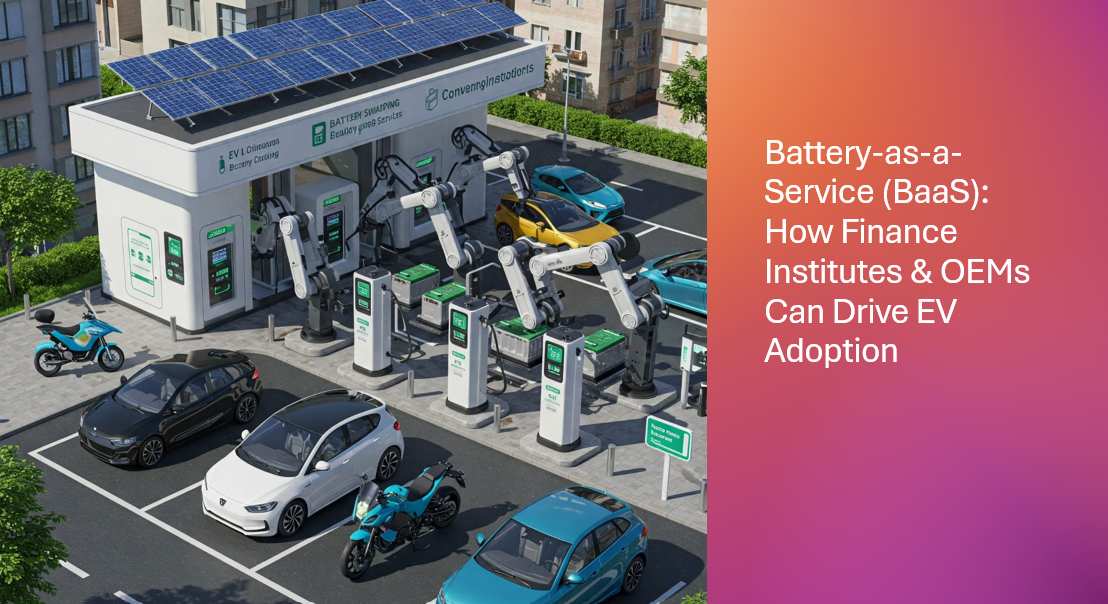The electric vehicle (EV) industry is rapidly evolving, but high EV battery costs remain a significant barrier for consumers. Battery-as-a-Service (BaaS) is an innovative solution that allows users to lease batteries instead of purchasing them outright. This model reduces the EV upfront cost, making electric vehicles more affordable and accelerating global EV adoption.
For BaaS adoption, financial institutions and original equipment manufacturers (OEMs) must collaborate strategically. In this article, we explore how finance institutes and EV manufacturers can engage in battery leasing, the benefits for EV owners, charging infrastructure, and the challenges involved—along with real-world case studies.
How Finance Institutes & OEMs Can Work Together in Battery Leasing
1. Battery Subscription Plans & Leasing Models
- Finance Institutes: Offer battery leasing options through EV financing and EMI-based payments.
- OEMs: Ensure battery compatibility, supply, and maintenance.
- Outcome: Customers subscribe to battery packs, lowering the total cost of EV ownership.
2. Battery Swapping Stations with Financed Infrastructure
- OEMs & EV Charging Companies: Set up battery swapping stations for quick energy replenishment.
- Banks & NBFCs: Provide financial backing for EV infrastructure investment.
- Outcome: Battery swapping reduces charging time from hours to minutes.
3. Residual Value Financing for Used EV Batteries
- Challenge: Battery performance declines over time, affecting resale value.
- Solution: Finance institutes provide residual value financing for used lithium-ion batteries.
- Outcome: Retired batteries are used in renewable energy storage applications, improving EV sustainability.
4. Battery Insurance & Risk Management
- Banks: Provide battery insurance coverage for theft, degradation, and replacement.
- OEMs & EV Battery Manufacturers: Ensure battery durability and performance monitoring.
Benefits of Battery-as-a-Service (BaaS) for EV Buyers & Charging Infrastructure
For EV Buyers
✅ Lower Initial Cost – EVs become 40%-50% cheaper, as the battery contributes nearly 40% of the total cost.
✅ Flexible Ownership – Users can upgrade to newer, more efficient EV batteries over time.
✅ Reduced Maintenance Expenses – Battery replacements and battery performance monitoring are handled by OEMs.
For Charging & Energy Infrastructure
⚡ Faster Charging Solutions – Battery swapping stations reduce wait times compared to traditional EV fast charging stations.
⚡ Lower Grid Load – Decentralized EV battery charging helps manage power grid demand efficiently.
⚡ Extended Battery Lifecycle – Controlled charging cycles improve the longevity of EV lithium-ion batteries.
Challenges & Solutions in Adopting Battery-as-a-Service
1. Lack of Battery Standardization
- Challenge: Different OEMs use varied EV battery sizes, making universal battery swapping difficult.
- Solution: Industry-wide standardization of battery packs to ensure cross-brand battery compatibility.
2. High Investment Costs for Battery Swapping Infrastructure
- Challenge: Setting up EV charging networks and swapping stations requires high capital investment.
- Solution: Public-Private Partnerships (PPP) and financing from banks for EV infrastructure development.
3. Battery Ownership & Responsibility Concerns
- Challenge: Uncertainty over EV battery ownership and who bears responsibility for performance issues.
- Solution: Finance institutes and OEMs must clearly define battery ownership models and risk-sharing mechanisms.
4. Consumer Awareness & Adoption
- Challenge: Many EV buyers are unfamiliar with battery subscription models.
- Solution: EV manufacturers and finance institutions must educate consumers on the benefits of battery leasing vs. ownership.
Real-World Case Studies & Market Trends
📌 NIO’s Battery Swapping Success in China
NIO, a Chinese EV manufacturer, has deployed over 2,200 battery swap stations worldwide, including 30 in Europe as of 2024. These stations have performed nearly 33 million battery swaps, showing the effectiveness of BaaS in EV adoption.
Source
📌 CATL’s Battery-as-a-Service Expansion
CATL, the world’s largest EV battery manufacturer, plans to establish 1,000 battery swap stations in China next year, aiming for 10,000 stations globally. Their goal is to make EV ownership more flexible and reduce EV charging time.
Source
📌 Gogoro’s Swappable Battery Network in Taiwan
Taiwan-based Gogoro has built over 12,000 battery swapping stations, serving 600,000+ EVs. This model has significantly reduced EV charging downtime and contributed to decarbonization in urban mobility.
📊 EV Market Growth: According to BloombergNEF, the global Battery-as-a-Service market is projected to grow at a 25% CAGR, reaching $20 billion by 2030, driven by increasing EV demand and battery leasing models.
Final Thoughts – The Future of Battery-as-a-Service in EV Mobility
The BaaS model has the potential to disrupt the EV market, making electric vehicles more affordable and charging infrastructure more accessible. However, success will depend on battery standardization, financial models, and consumer awareness.
Would you consider leasing a battery instead of buying one? Share your thoughts in the comments!








Leave a Reply